|
Laser Plasma based Electron Accelerator
Particle (electron/proton/heavy ion) accelerators are required for variety of scientific, industrial and medical applications. High-energy accelerators are also essential tools to probe the nature at smallest length scales and hence help in finding answers to fundamental questions. These accelerators are based on radio-frequency (RF) cavity where the acceleration field gradient is limited to < 100 MV/m, due to electric field induced breakdown on the walls of the cavity. Consequently, such accelerators are naturally quite big in size e.g. Stanford Linear Accelerator (SLAC), USA and Large Hadron Collider (LHC), CERN, Geneva, and proposed International Linear Collider (ILC). Development of such accelerators involves huge cost and time, therefore requires multinational collaborations. This has led scientific community to look for alternate methods of charged particle acceleration with higher acceleration gradients so that comparatively low cost and compact accelerators could be built. This would facilitate wider availability of accelerators for variety of applications e.g. developing compact x-ray / g-ray sources, medical applications e.g. in cancer therapy, sterilizing food and drugs, treating materials used in industry, and disposing of nuclear waste etc.
Among various methods high-power (several TW to PW), ultra-short (in the femtosecond regime) laser pulses are being considered. When focused to tiny spots (few to tens of micrometers diameter) high intensity of >1018 W/cm2 are generated which has associated huge electric field of >TV/m. Various schemes of using electric field associated with intense laser pulse (in vacuum, in periodic varying magnetic field etc.) have been proposed and being investigated experimentally also. Such schemes are generally termed as Direct Laser Acceleration (DLA) as it involves energy transfer directly from laser to the electrons. DLA is also possible in ‘plasma’. Electrons can also be accelerated by collective fields produced inside plasma due to charge separation by an intense, ultra-short laser pulse propagating inside plasma, a scheme known as Laser Wake-field Electron Acceleration (LWFA). Plasma as a medium for particle acceleration has an advantage that being already in the broken state and therefore it has no electrical breakdown limit, like conventional accelerating structures, and thus support large accelerating field ~ 100 GV/m. Hence laser driven plasma based acceleration i.e. Laser Plasma Acceleration (LPA) is a seen as a potential candidate for development of compact and low cost accelerators.
Energy Gain Mechanisms in LPA: LWFA and DLA
An ultra-high intense (>1018 W/cm2), ultra-short (few 10’s of fs) laser pulse when passes through a plasma, the plasma electrons are pushed forward at the leading edge of the laser pulse and backward at the trailing edge of the laser pulse due to "ponderomotive force", a force which is proportional to the intensity gradient () of the laser pulse and arises due to non-linear part of the Lorentz force of the laser field on the electrons. The ponderomotive force pushes electrons from the region of high laser intensity to the low intensity region (Fig. 1). As the laser pulse propagates in the plasma, the displaced electrons try to snap back to their equilibrium position to maintain charge neutrality. However, while doing so they overshoot the equilibrium position which sets up electron oscillations behind the laser pulse. This electron oscillation moves behind the laser pulse with a phase velocity equal to the group velocity of the laser in the plasma which is close to ‘c’, the velocity of light in vacuum as depicted in the figure below. These moving plasma oscillations are called ‘electron plasma wave’ or simply ‘plasma wave’. The plasma wave is associated with longitudinal electrostatic field which is termed as ‘Laser Wake-field’ as this is generated in the wake of the laser pulse similar to the water waves generated in the wake of a moving speed boat in water.
In order to excite high amplitude plasma waves, it is necessary that the laser pulse duration is short so that the corresponding ponderomotive force is stronger due to higher intensity gradient. Also, when the laser pulse length (L = ct, where t is laser pulse duration defined as FWHM: full width at half-maximum) matches with half the plasma wavelength (lp) i.e. L » lp/2, the plasma wave is resonantly excited and produces large amplitude wake-field. For typical plasma densities suitable for LWFA in the range of 1017–1019 cm−3, this corresponds to drive laser beams with pulse lengths in the range of ~150−15 fs, i.e. in the ultra-short regime.
An intense laser pulse can drive high amplitude i.e. highly non-linear plasma waves. In fact it forms a region completely void of electrons behind the laser pulse termed as ‘bubble’. Depending on interaction conditions it may also lead to formation of a long ion channel behind the laser pulse. The maximum amplitude of the wake-field is limited by wave-breaking amplitude of the plasma wave which in the limit of cold non-relativistic case is given by:
 where ne is the plasma electron density where ne is the plasma electron density
For plasma electron density of about ~1018 cm-3, the maximum wake-field will be ~100 GV/m. This acceleration field is approximately three orders of magnitude higher than that available with conventional RF based accelerators.
The electrons self-injected into the plasma wave are accelerated and a high energy electron beam is produced in direction of laser propagation. 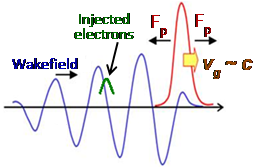
Fig 1. Laser wakefield generation in plasma and electron acceleration
In addition to the energy gain by wakefield, electrons can also gain energy from the laser electric field directly i.e. through DLA mechanism, while oscillating transversely in the bubble or ion channel formed by the intense laser pulse. Role of DLA in intense laser plasma interaction in different conditions and also in the wakefield/bubble regime is one of the aspects of current investigations associated with LPA.
Experiments on LPA at Laser Plasma Division, RRCAT, Indore
At Laser Plasma Division, we are pursuing a programme on experimental investigations on LWFA. Experiments have been carried out using CPA based 10 TW, 45 fs and 150TW, 25fs Ti:sapphire laser systems. The schematic of the set up is shown in Fig. 2.
Using 10TW laser providing > 1018 W/cm2 of intensity on He gas jet target having electron density in the range of 1 - 10 x1019 cm-3 was used. While working in the SM-LWFA regime, we have been able to generate quasi-monoenergetic electron beams with energy in the range of 20-50 MeV and a beam divergence of <10 mrad, at specific values of electron density (Fig. 3). The effect of the laser pulse chirp and laser pre-pulse on the electron beam generation was also studied. With the proper choice of focusing optics (focal length of the off axis parabola) and controlling the ASE pre-pulse intensity below the pre-plasma formation threshold, high quality, stable electron beams with almost no low energy electrons background have been generated using He gas jet target. A comparative study with different gases (He, N2, and Ar) was also performed.
Next, we have demonstrated generation of high quality quasi-monoenergetic electron beam with peak energy ~ 12 MeV, from self-guided LWFA in a plasma plume produced by laser ablation of solid Nylon (C12H22N2O2)n target (Fig. 3). This technique has a potential to produced accelerated electron beam at high repetition compared to gas jet targets.
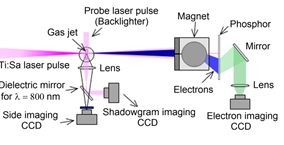
Fig. 2: Schematic of the experimental |
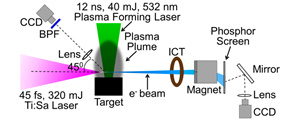
Fig. 3: Schematic of the experimental setup for LWFA in plasma plume produced from solid target |

Fig. 3: Energy spectra of the quasi-monoenergetic electron beam produced from He gas-jet plasma recorded in 15 consecutive shots.
|
Recently, investigations on LPA were performed using 150 TW, 25 fs Ti:sapphire laser system with emphasis on determination of different acceleration mechanisms applicable in varying laser and plasma conditions (Fig. 4). Direct laser acceleration (DLA) and hybrid regime of acceleration (DLA + wakefield) of electrons in different gas-jet targets of He, N2, Ar and mixed gas targets of He + N2 were identified. Electron beams with few tens of MeV energy with quasi-thermal distribution, and also quasi-monoenergetic (energy spread ~21%) electron beams with peak energy of ~168 MeV were observed. Hybrid regime of acceleration in He has demonstrated acceleration of electrons to >500 MeV energy (Fig. 5). Further, radiography application of relativistic electron beams was explored (Fig. 6). Further, LPA process was also understood through theoretical model for estimation of energy gain by DLA and wakefield and dephasing effects and 2D PIC simulations.
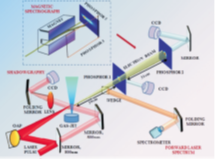
Fig. 4: Schematic of experimental |
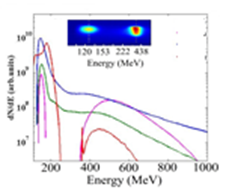
Fig. 5: High-energy electron acceleration in 4mm He gas-jet |
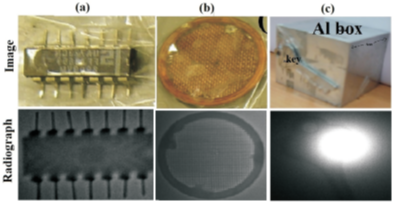
Fig. 6: Electron beam radiography of various
|
For more detail please see the publications appearing on the website. |







 where ne is the plasma electron density
where ne is the plasma electron density












